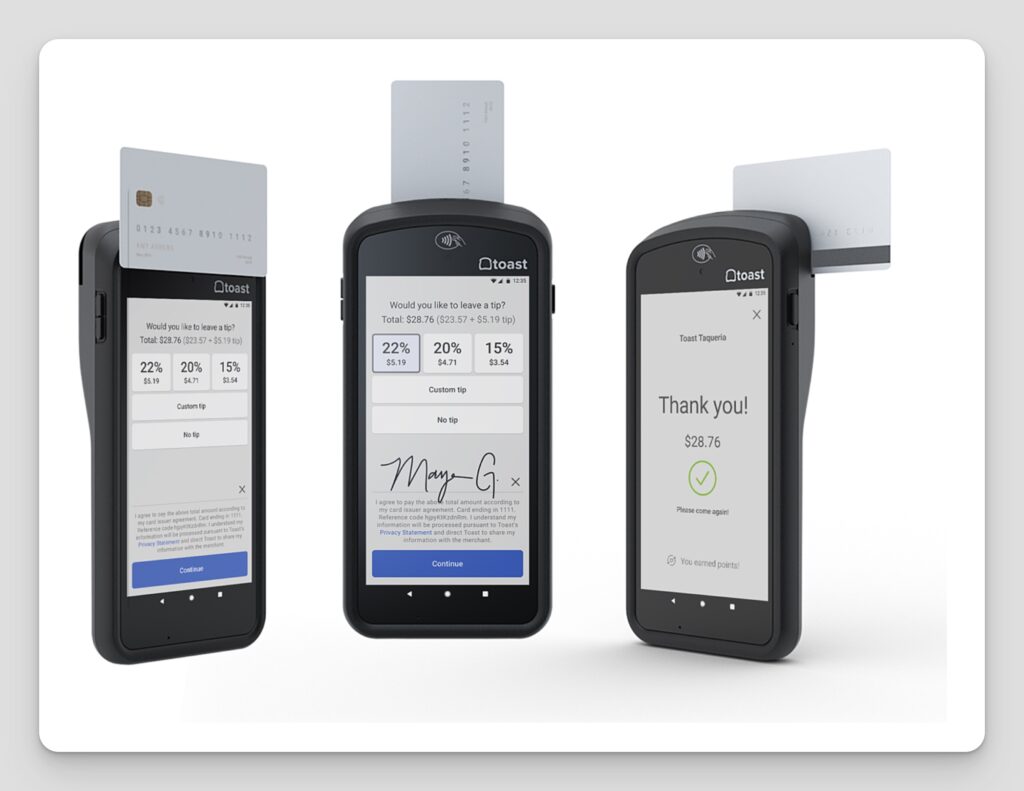Choosing the right coffee shop POS system is crucial for your cafe’s success.
With a vast number of options available in the market, making a decision can be overwhelming.
To provide clarity, I have thoroughly researched the top-rated coffee shop POS systems, considering their features, capabilities, and user feedback.
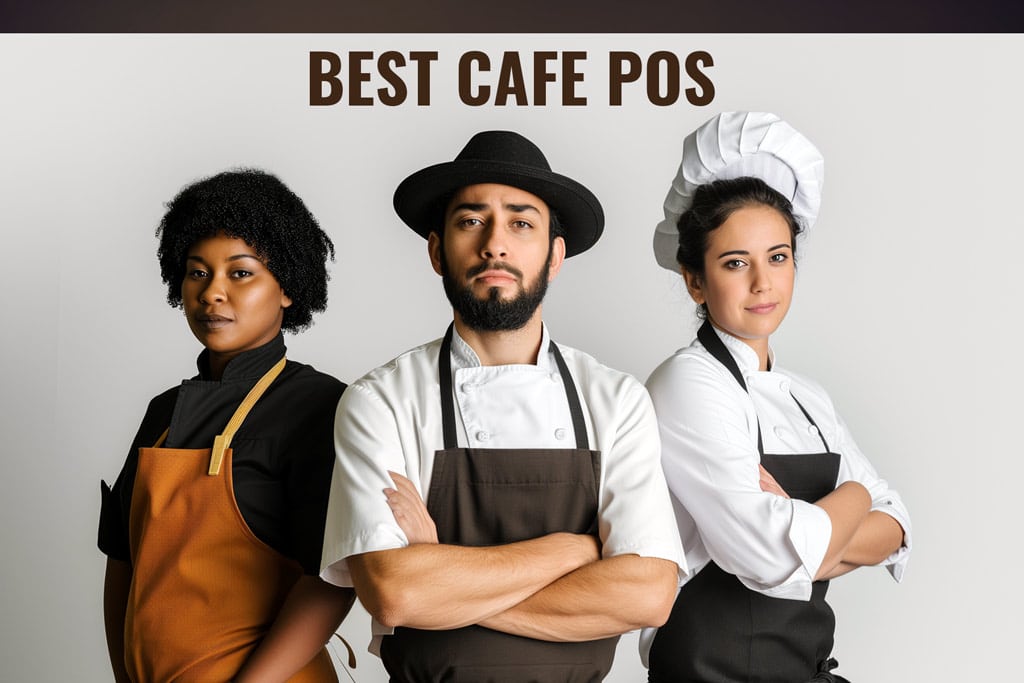
In this concise 2024 overview, you’ll find a comprehensive guide examining the pros, cons, and key factors of each system.
This will simplify your research process and help you choose the best coffee shop POS system for your business with confidence.
My 5 Top Picks for the Best Coffee Shop POS
Toast – Best for larger coffee shops that serve food and want takeout and online ordering features.
Square – Best for new or smaller coffee shops that want to start on a subscription-free plan.
SpotOn – Best for cafes with outdoor seating looking for mobile hardware options.
Lightspeed – Best for upscale cafes seeking powerful analytics and retail features.
TouchBistro – Best for cafes looking for a fast and feature-rich system.
Note: Our reviews are reader-supported. We may earn affiliate commissions from links on this page. Learn more…
Toast
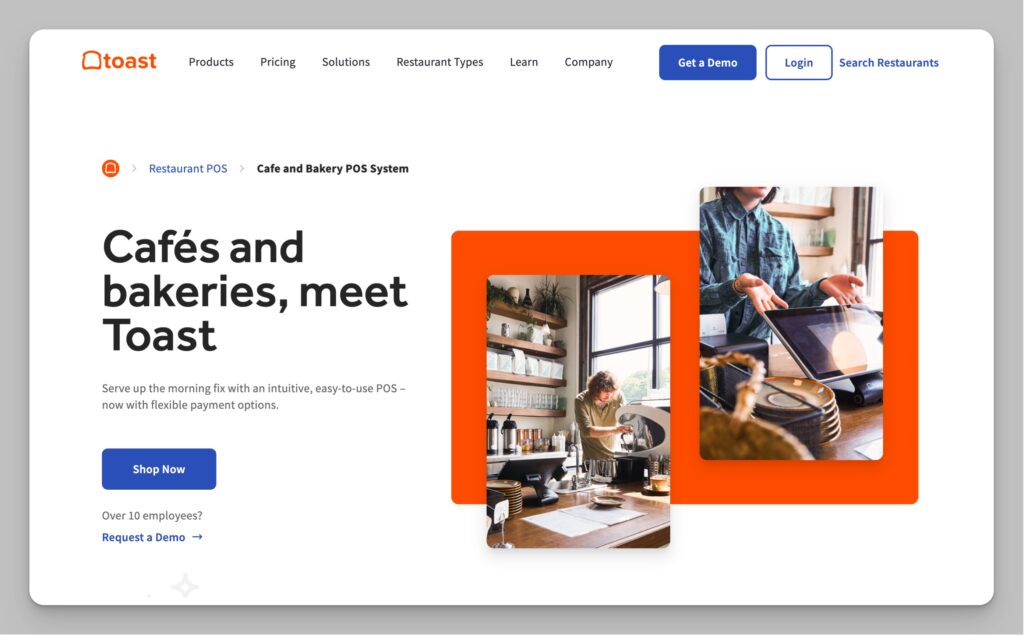
Toast has rapidly emerged as an influential player in the restaurant technology industry, gaining attention through its remarkable growth and strategic acquisitions. In recognition of its innovation, Fast Company named Toast one of the most innovative companies of 2023.
Designed to be a comprehensive coffee shop operating system, the new Toast for Cafés and Bakeries solution released in 2023 positions itself as a one-stop shop for cafe shop owners and operators.
The platform covers functionalities tailored to the unique needs of cafes, such as efficient handling of high volumes of customizable orders, robust inventory management for both retail and food service, and capabilities to expand into catering and wholesale.
Some of the new features for coffee shops include:
- Allowing custom modifiers and options for each menu item
- Support for barcode scanning or manual entry for retail products
- A unified system to track stock levels and transfers across multiple locations
- Integrated tools to manage catering and wholesale channels effectively
- A retail POS system for selling merchandise and packaged goods
Read more: The new features of Toast for Cafés & Bakeries
Built upon feedback from café and bakery owners, Toast for Cafés & Bakeries is an intuitive POS system that caters to the core pain points that bakeries typically face.
Toast Pricing & Hardware
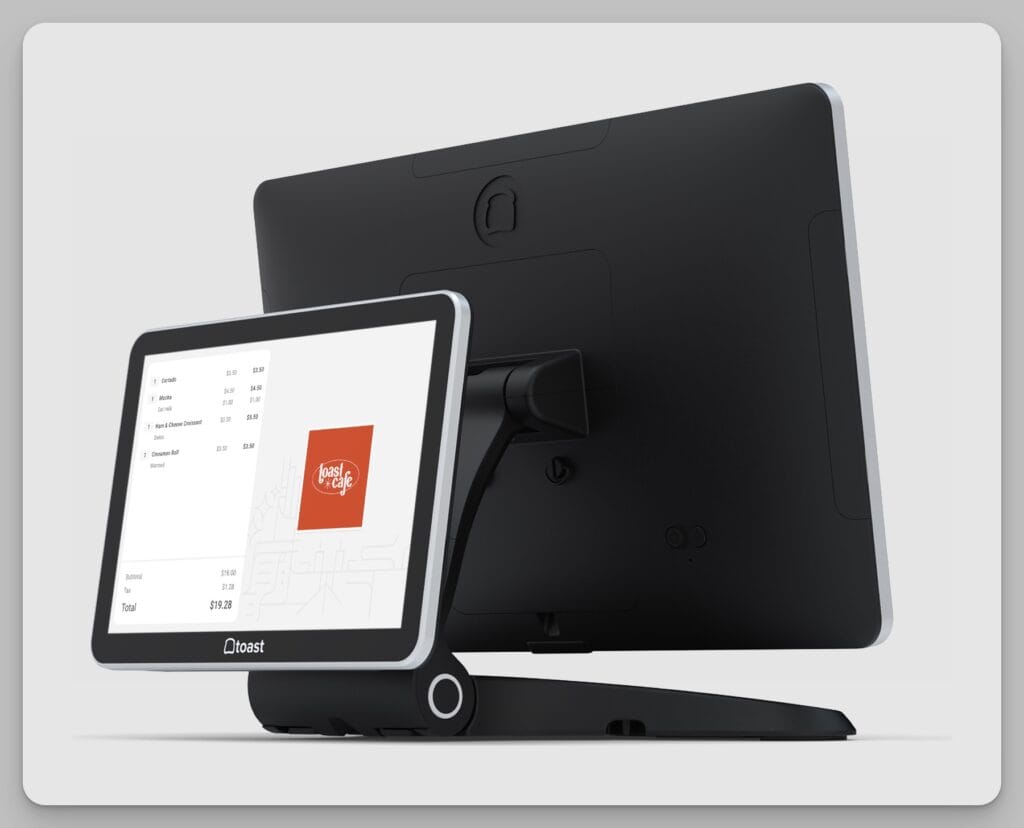
Toast User Reviews
Here is a summary of my analysis of user reviews, testimonials, and complaints about Toast as seen on major review sites like Capterra, G2, and others.
- User-Friendly Interface: Many Toast users express satisfaction with the system’s user-friendly interface. They find that the software is easy to navigate, and training new employees is straightforward due to its intuitive design.
- Customization and Flexibility: Users appreciate the high level of customization available with Toast POS. The system allows them to tailor the POS to their specific business needs, from table layouts to menu configurations.
- Comprehensive Reporting: The reporting features of Toast POS are praised by several users. They find the reports easy to tailor to their needs and are pleased with the ability to download them into different formats for further analysis.
- Effective Tableside Ordering: The handheld devices for tableside ordering receive high marks for their ease of use and ability to increase efficiency for service staff, allowing them to spend more time with guests.
- Mobile and Cloud-Based: Toast’s mobile compatibility and cloud-based platform are highlighted as beneficial, enabling business owners to manage their operations and access real-time data from anywhere.
- Technical Problems and Outages: Some reviewers report experiencing technical issues with the system, including network-wide crashes and offline payment processing errors, which occasionally cause entry errors and disrupt operations.
- Additional Costs and Fees: Fees associated with certain features and payment processing rates are a point of contention for some users, who believe these fees can be excessive and not fully transparent.
- Limited Quick Service Features: Toast POS is criticized by some quick service restaurants for its limited feature set tailored to their business model, suggesting improvements in order management and throttling.
- Problematic Payroll Service: There are some complaints specifically about Toast’s payroll service, with users advising others to avoid it due to errors in tax reporting and other difficulties.
- Installation and Setup Challenges: A few users find the self-install process to be complicated, noting that initial setup could be smoother and sometimes requires intervention from company representatives.
- Issues with Customer Service: A common theme among the negative reviews is dissatisfaction with customer service. Users complain about receiving minimal support from customer service representatives, stating they often follow scripts with limited product knowledge.
Where Toast Stands Out for Cafes
Toast offers a comprehensive suite of features and benefits that make it an ideal choice for coffee shops. Designed with user-friendliness in mind, Toast has intuitive screens for quick order entry and modifications, making it easy to use and grow with your business.
Enhanced Guest Experience: The quick order mode ensures prompt service for food bites and coffee rounds. Moreover, with Toast Mobile Order & Pay, guests can skip the line, order, and pay seamlessly, which typically results in a 10% increase in revenue for cafes using it.
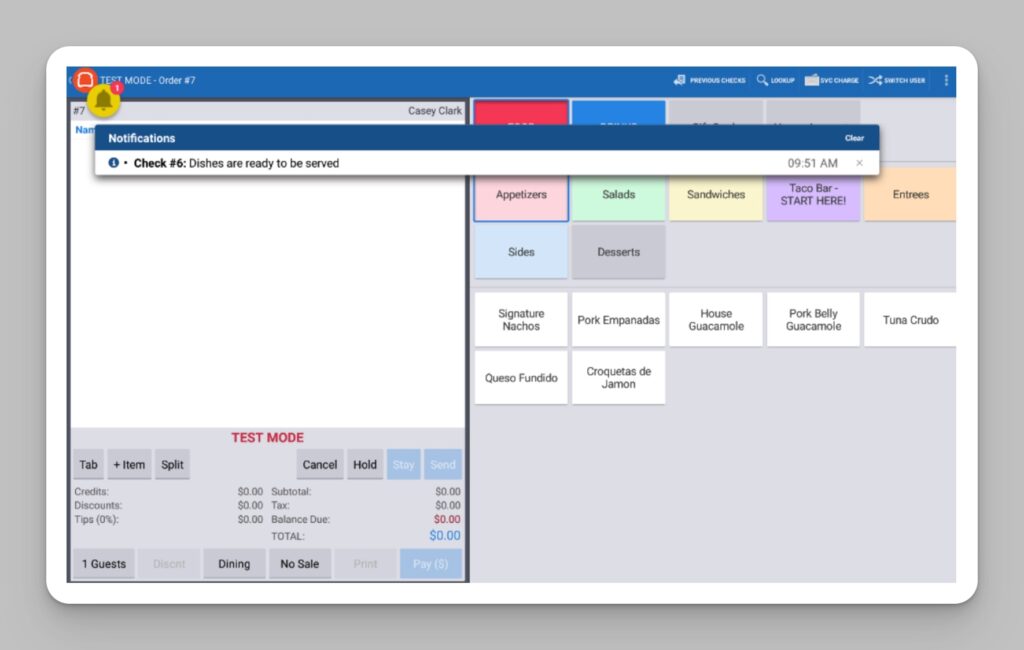
Intuitive Kitchen Display System (KDS) and Inventory Management: Toast helps keep your cafe running smoothly with its easy-to-use KDS and inventory management features. You’ll also have access to a whole ecosystem of 100+ partners to make closing out at 2 AM less painful.
Efficient Operations: Toast has an intuitive interface that simplifies splitting checks and tabs, even in high-volume environments. Its ability to handle complex transactions quickly and accurately ensures better service for customers.
Robust and Quick Hardware: Toast’s hardware is designed to withstand challenging coffee shop environments, remaining reliable despite spills and splashes. Its durability and speed enable efficient customer service.
Effective Loyalty Programs: You can implement Toast’s loyalty program to retain customers and encourage repeat business. Within weeks, the program can yield a significant number of sign-ups. By rewarding repeat visits with discounts or free items, customer retention and repeat business are enhanced.
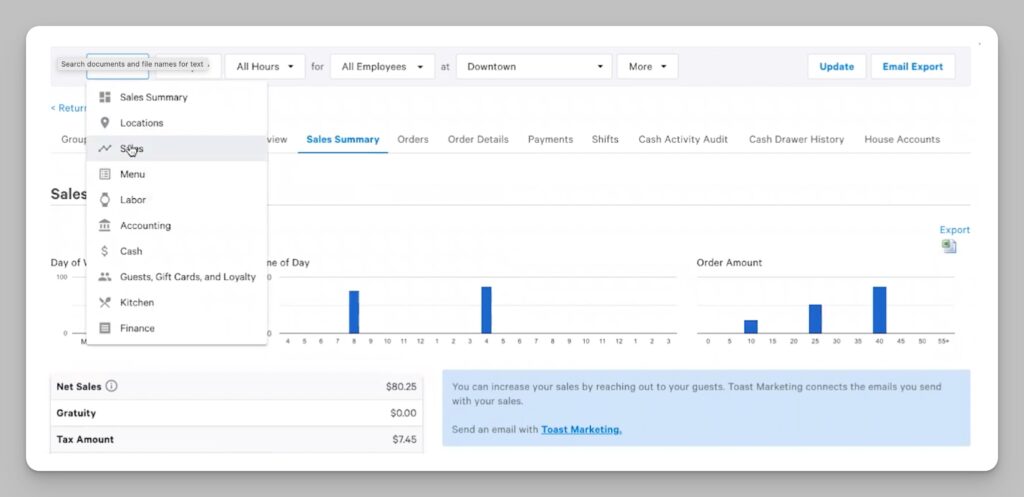
Data-Driven Decision Making: Toast’s reporting and analytics features empower you to make data-driven decisions. Sales data can be used to identify best-selling items, allowing menu adjustments accordingly. Real-time data helps manage orders and sales more effectively, while customer data from the loyalty program enables personalized marketing efforts and improved customer relationships.
Mobile Payment and Ordering Technologies: Toast’s mobile payment and ordering technologies offer several advantages for your coffee shop. Customers can place orders directly from their mobile devices, reducing long lines and wait times during busy periods.
Contactless Payment: Including Apple Pay and Google Pay adds convenience and safety. The mobile POS system allows staff to take orders and process payments directly from a tablet anywhere in the coffee shop, improving service speed and efficiency.
Marketing and Loyalty Tools: Toast’s marketing and loyalty tools can significantly benefit your cafe. Its built-in loyalty program encourages repeat business and helps build a loyal customer base.
Email marketing capabilities allow you to send out promotional emails, newsletters, or special offers, driving repeat business and keeping your cafe top-of-mind for customers.
Where Toast Can Improve
- Locked into Toast Payment Processing: Users are required to use Toast’s in-house credit card processing solution, restricting their ability to shop around for potentially better or more affordable alternatives.
- Add-ons Can Get Expensive: While Toast POS offers a range of valuable add-ons to help restaurants enhance their operations, these extra features often come with additional costs. These expenses might be prohibitive, especially for small or start-up establishments looking to maintain a low-budget operation.
- Not Very Transparent Pricing: Another downside of Toast POS is the lack of transparent pricing information on the website, including the various hardware bundles and add-on features. This can make it difficult for potential clients to compare Toast POS with other providers.
- Only Available in a Few English-speaking Countries: Toast is only available in a select few English-speaking countries, limiting access for restaurants operating outside these markets. This geographical restriction may make Toast POS less desirable for global or multi-national brands looking for a comprehensive solution across all their locations
Key Takeaways about Toast for Cafes:
- Enhanced guest experience through quick order modes and mobile order & pay.
- Intuitive kitchen display system (KDS) and inventory management features.
- Efficient operations, including check splitting in high-volume environments.
- Reliable hardware designed for durability in coffee shop settings.
- Enhanced customer experience with real-time updates and contactless payments.
- Effective loyalty programs to retain customers.
The most innovative POS system on the market
Best for larger coffee shops that serve food and want takeout and online ordering features.
- Rapid development of new features
- Toast Takeout system
- Rugged mobile hardware devices
- Android only
- Locked into Toast payment processing
Square for Restaurants

Square is the perfect solution if you need a free plan, smooth coffee shop transactions and easy-to-operate retail features.
The system values speed and operational efficiency, ensuring quick order entries. Square’s unique aspect, the conversational modifiers, simplifies how orders are written, modernizing this duty and making it more effortless.
Additionally, Square offers effective marketing and loyalty program tools, aiding café owners in connecting with their customers effectively.

Square’s payment system is inclusive, accepting several methods, focusing on safety, and providing quick transactions. Comprehensive data analysis and reporting are also available, giving cafés a clear perspective on their operations and performance.
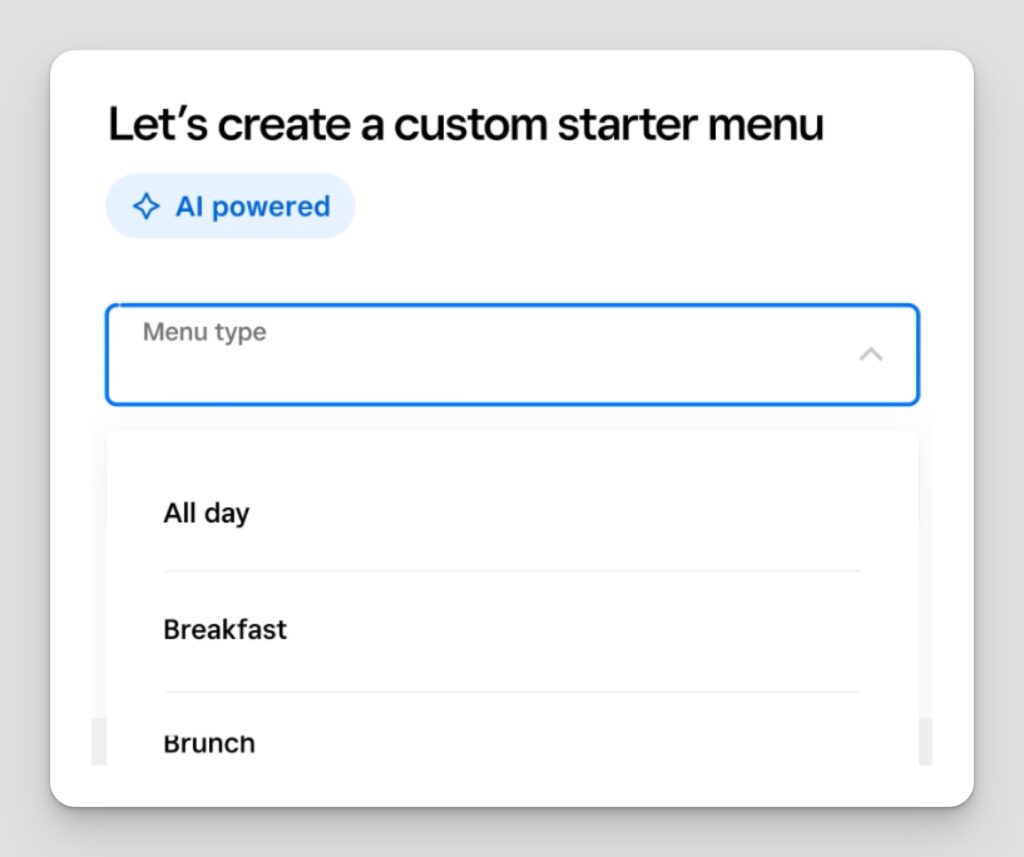
In 2023 Square has introduced 10 AI-powered tools that can benefit coffee shop owners by automating operations, improving workflows, and saving time. These tools include:
- AI Menu Generator that allows coffee shops to quickly create menus with ingredients, descriptions, and pricing. It saves time and simplifies the process of updating menus frequently.
- Visual Asset Creation for creating high-quality images for menus, websites, and social media, eliminating the need for elaborate photoshoots.
- Automated Content Creation for marketing emails, social media captions, and announcements. It provides near-finished promotional content, freeing up staff to focus on hospitality.
- Square KDS Operations Optimization: Improves kitchen workflows by assigning new menu items to appropriate station screens and suggesting preparation times.
Square Pricing & Hardware

Square User Reviews
Here is a summary of my analysis of user reviews, testimonials, and complaints about Square for Restaurants as seen on major review sites like Capterra, G2, and others.
- Ease of Setup and Use: Many users commend Square for its user-friendly setup process and intuitive design. The system is easy to configure, adaptable for various devices including iPads and smartphones, and provides quick access to online market tools.
- Cost-Effective: Business owners appreciate the affordability of Square for Restaurants. The pricing is competitive, and the system offers a variety of financial management tools such as integrated payment processing which contributes to a low-stress financial experience.
- Efficient Sales Tracking and Payment Processing: The app has been highlighted for its capabilities in sales monitoring and secure payment processing, with immediate transaction fees rather than monthly billing.
- CRM and Website Integration: Users appreciate the CRM tools provided by Square and find the website creation services particularly beneficial for enhancing their online presence, which is especially notable for quick transitions to online ordering during events like the pandemic.
- Resourceful Features: Square for Restaurants POS is valued for its many features that assist in business operations, including inventory tracking, promotional offers, loyalty rewards, customer feedback collection, and seamless QuickBooks integration.
- Complex Restaurant Issues: Some users report that Square for Restaurants is not ideal for complex restaurant operations. Glitches have led to crashes, with systems becoming unresponsive during busy times, causing major distress for restaurant owners. The system is also criticized for being unable to handle the intricacies of a full-service restaurant setting.
- Customization Limits: Certain users find it tedious to customize menus and loyalty programs. Adjustments to the system may require excessive steps, which can be frustrating, especially for businesses with frequently changing offerings.
- Technical Support Concerns: There have been complaints regarding the level of technical support provided by Square. Troubleshooting complex issues has sometimes proven difficult, with tech support struggling to resolve problems effectively. Furthermore, the lack of on-site support from Square when compared to competing products is a significant drawback for some users.
- Inadequate Reporting: Users have mentioned that the reporting feature for Square for Restaurants POS could be improved. Detailed drill-down reports are lacking, making it cumbersome for business owners to analyze sales and inventory effectively.
- Hardware Problems: Issues with the card reader have also been mentioned, with it occasionally rotating during a swipe and causing a read error, although solutions like anchoring the reader have been used to fix it.
Where Square Stands Out for Coffee Shops
Speed and Efficiency: Square’s POS system is built for speed, enabling fast order entry and efficient back-of-house operations. It also allows for real-time menu updates across devices and the ability to repeat an order in a few taps.
Conversational Modifiers: This feature speeds up the ordering process by allowing you to enter orders in a conversational manner, which is more intuitive and quicker than traditional methods.

Square Kitchen Display System (KDS): This system keeps the entire coffee shop in sync, managing all orders from one screen. It helps handle the rush and reduce costs with digital tickets, ensuring orders are prepared correctly.
Online Ordering: Square for Restaurants allows for online ordering with no monthly fees or commissions. It supports Instagram and Facebook ad integration and syncs online orders with the point of sale.

Marketing and Loyalty Programs: Square has tools to create, send, and track email and social media campaigns. It also offers a loyalty program that rewards repeat customers, which can be set up at checkout in a few seconds.
Payments: Square accepts all types of payments quickly and securely, whether you’re tableside, behind the bar, online, or on the go. It offers next-day transfers, no chargeback fees, and end-to-end encryption for PCI compliant payments.
Insights and Reporting: Square provides detailed data and custom reports to help you understand your business. You can see real-time sales directly on your POS, run reports by daypart, covers, employees, comps, and voids, and get alerts when inventory is low.
Where Square Can Improve
Limited Advanced Features: Square may lack some advanced features offered by other POS systems, such as in-depth inventory management and comprehensive reporting tools
Complex Reporting: The reporting features are causing concerns because they lack sufficient detail and are complex, making it difficult to search for specific information. Additionally, the process of reconciling sales to receivables is lengthy.
Lack of On-Site Support: Square for Restaurants does not provide on-site support, which may not be suitable for businesses that rely on in-person assistance.
Key Takeaways of Square for Cafes:
- Speedy order entry and intuitive conversational modifiers for efficient operations.
- Square Kitchen Display System (KDS) to manage orders from one central screen.
- Integration with third-party partners for inventory management and other functions.
- Hardware options tailored to the needs of cafes, including handheld devices for tableside service.
- Online ordering features with no monthly fees or commissions.
- Marketing tools and loyalty programs to engage customers.
- Secure payment processing with detailed insights and reporting capabilities.
The fast and easy-to-use system
Best for new or smaller cafes that want to start on a free plan and want to sell products online.
- Subscription free plan
- No long term contracts
- Integrates with the Square ecosystem
- Lacks some advanced features
- No on-site support
SpotOn Restaurant

SpotOn is emerging as a top cloud-based cafe POS system, catering to coffee shops, cafes, and bakeries.
It offers a comprehensive range of core restaurant POS features, along with numerous advanced features and add-ons.
Despite being a newcomer in the food service POS scene, SpotOn stands out with its extensive feature set and diverse hardware choices.
Founded in 2017 and headquartered in San Francisco, this company has quickly gained recognition in the industry.
SpotOn Pricing & Hardware

SpotOn User Reviews
Here is a summary of my analysis of user reviews, testimonials, and complaints about SpotOn as seen on major review sites like Capterra, G2, and others.
- Ease of Use & Training: SpotOn POS is frequently recognized for its user-friendly interface, even among those who are not tech-savvy. Users report a smooth learning curve and find the system highly functional. Training sessions are lauded for their effectiveness and SpotOn’s local tech support is often highlighted for their friendliness and help with system modifications.
- Customer Support & Responsiveness: Local customer support is consistently praised, with many users expressing satisfaction regarding the attentiveness and helpfulness of their local representatives. The team’s dedication to resolving issues and guiding clients through challenges is appreciated, alongside their hands-on assistance during setup.
- Flexibility and Customization: The flexibility of SpotOn’s hardware and the ability to customize the software is a strong point. Many restaurants benefit from handheld devices and the multitude of functions offered, which contribute to improved service speed and order accuracy.
- Increased Efficiency & Savings: The system is credited with helping businesses increase revenue and save costs. Positive impacts include a boost in online orders, enhanced workflow through devices and integrations, and cost savings from features like cash discount programs.
- Integration and Real-time Reporting: SpotOn users are pleased with the software’s integration capabilities, especially with online ordering. Real-time reporting with detailed insights is also frequently mentioned as a vital tool for business operations.
- Implementation Challenges: Some users experienced rocky initial launches with aspects such as gift card processing and loyalty programs presenting hurdles. Reporting also required adjustments for specific business needs.
- Credit Card Processing Issues: Users have encountered difficulties with credit card reader functions and card payment processing, including fees charged to gift card payments. Issues like these have been a source of frustration that required technical assistance to resolve.
- Hardware and Software Quirks: A few reports indicated glitches with the occasional technical quirk, like sensitive screens or cumbersome steps on handheld devices. Device limitations, such as the inability to scan UPCs or process offline payments, were also noted.
- Learning Curve & Complexity: Although overall user-friendly, some accountants and management staff found the array of options and reports slightly overwhelming at first, highlighting a learning curve mainly for back-office functionalities.
Where SpotOn Stands Out for Cafes
Excellent Coffee Shop Hardware Devices: SpotOn has a wide variety of hardware options to meet the needs of different types of restaurants and coffee shops. These options include touchscreen stations, handheld devices, customer-facing displays, self-service kiosks, and kitchen display systems. The hardware is designed to be robust and reliable in a cafe environment.
Integrated Tools for an All-in-One Solution: Going beyond a standard POS system, SpotOn provides an all-in-one solution with a variety of integrated tools. These tools consist of advanced reporting, marketing and review management, and loyalty programs, all tailored to unlock your cafes earning potential and transform your operations.

Efficient Order Management and Simplified Service: A key strength of SpotOn is its efficient order management. Whether customers order at the counter or from their table using a handheld payment terminal, SpotOn organizes orders by table, simplifying management and service.
This feature, coupled with the system’s reporting capabilities, significantly reduces closing times and allows your staff to focus more on customer engagement.
Real-Time Order and Payment Processing with SpotOn Serve: SpotOn’s handheld devices, known as SpotOn Serve, facilitate real-time order and payment processing right at the table. This results in quicker service, increased table turnover, and ultimately, higher sales.
Additionally, the system empowers customers by giving them more control over their ordering experience. With QR code ordering, customers can manage their own orders, making bar tabs easier to handle and enhancing the overall guest experience.

Data-Driven Approach for Strategic Decision-Making: The system also offers real-time data on sales trends, enabling you to adjust menus on the fly, add promotional items to boost sales, and over time, predict what will sell on any given day of the week. This data-driven approach can change the way you manage your operations and make strategic decisions.
Loyalty Programs and Marketing for Customer Retention: SpotOn also incorporates features for loyalty programs and marketing, which can help convert first-time customers into lifelong regulars, improve customer retention, and increase revenue.
Where SpotOn Falls Short
SpotOn has some limitations that may make it less attractive to specific businesses.
- It only works with SpotOn’s hardware, which could disadvantage businesses that have already invested in other POS hardware or prefer a different hardware provider.
- Using payment processing services other than SpotOn’s can be expensive. SpotOn charges a commission of 1.99% + $0.25 for regular transactions, which is quite low, but 2.99% + $0.25 for reward, corporate, international, and keyed-in card transactions.
- The POS system of SpotOn is dependent on the cloud and the offline functionality is not as robust as for example that of TouchBistro
- SpotOn offers various add-on features such as loyalty programs and website building, these add-ons can make the overall cost of the system high.
Feature rich all-in-one POS solution with modern bar-specific features
Best option for bars with outdoor seating looking for great mobile hardware devices.
- Wide selection of hardware devices
- Low credit-card processing fees*
- No long term contracts
- Limited offline functionality
- Requires SpotOn devices
- *Requires SpotOn Payment for low fees
Lightspeed

Lightspeed Restaurant is a robust, cloud-based POS system created specifically for the food service industry. Whether you’re running a small café or a chain of cafés, Lightspeed offers a wide range of features that can be customized to meet your specific needs.
One interesting thing about Lightspeed is the use of advanced technology to simplify tasks for users. This includes blockchain-based technology, real-time analytics, customizable workflows, and a variety of integrations.

All these features come in a user-friendly interface compatible with iOS-based devices. The system can also work offline, making it a reliable option in a wide range of scenarios.
In short, Lightspeed can be an effective choice for café owners seeking a POS platform tailor-fit to their specific business needs and preferences.
Lightspeed Pricing & Hardware

Lightspeed User Reviews
Where Lightspeed Stands Out for Cafes
Customizable layouts and menus: Design personalized floor plans that represent your cafe’s layout and seating arrangements. Create multiple menus tailored to specific devices, shifts, or events.
Automated inventory management: Track your stock and manage ingredients effortlessly with Lightspeed’s automated inventory system, ensuring you never run out of your customers’ favorite coffee.
Lightspeed Payments: Integrates AI and blockchain technology for a single, universal sign-on at any point of purchase globally. Each transaction is recorded on a private blockchain, potentially enhancing security and traceability.
Integration with delivery apps: Synchronize your menu with major food delivery apps like UberEats, allowing you to manage all online orders in one place and expand your reach to customers who prefer to enjoy their order at home.
Tab management: Easily manage and split tabs for groups, allowing your customers to conveniently pay for their drinks separately or together.

Sleek POS hardware: Lightspeed offers high-quality hardware designed specifically for restaurants and coffee shops, including technology that works offline and printers that can handle the humidity of a busy cafe environment.
TrueSync Technology: This feature ensures that operations continue smoothly even during internet outages. It prevents the loss of orders when the Wi-Fi signal drops, thereby maintaining the trust and satisfaction of customers.
Intuitive Interface: Lightspeed is known for its intuitive interface, which allows new staff to learn the basics of the system in just a few minutes. This rapid onboarding capability is crucial for coffee shops with high customer volumes and fast-paced service. It enables new staff to get started quickly, ensuring that operations run smoothly even during busy periods.

Advanced Reporting: The system also includes advanced reporting features that provide clear visibility on daily sales. These features are particularly useful for cafes with a wide selection of coffee, as they help with inventory management and ordering.
Where Lightspeed Falls Short
While Lightspeed Restaurant is a highly regarded system, there are some areas for improvement and potential drawbacks to consider.
- Price: Lightspeed is more expensive than some other POS systems on the market. While the system offers a range of features and benefits, the cost may be a barrier for some cafe owners, especially those who are just starting out.
- Limited Customization: While Lightspeed’s interface is user-friendly, it may not offer as much customization as some coffee shop owners would like. For example, some users have reported that it’s difficult to customize the layout of the order screen, which can impact efficiency during peak hours.
Key Takeaways of Lightspeed for Coffee Shops:
- Customizable layouts, menus, and advanced inventory management features
- Efficient payment options such as credit cards, debit cards, mobile payments, etc.
- Tab management for managing multiple orders across tables
- Training mode ensures quick onboarding is possible even during busy periods
- Robust data reporting capabilities empower cafe owners to make informed decisions
- Advanced customer engagement options include loyalty programs
Cleverly crafted POS with exceptional design
Best for upscale coffee shops seeking powerful inventory, data insights, and retail features.
- Ease of use & interface design
- Reporting & analytics
- E-commerce capabilities
- Limited offline functionality
- Not the cheapest option
TouchBistro
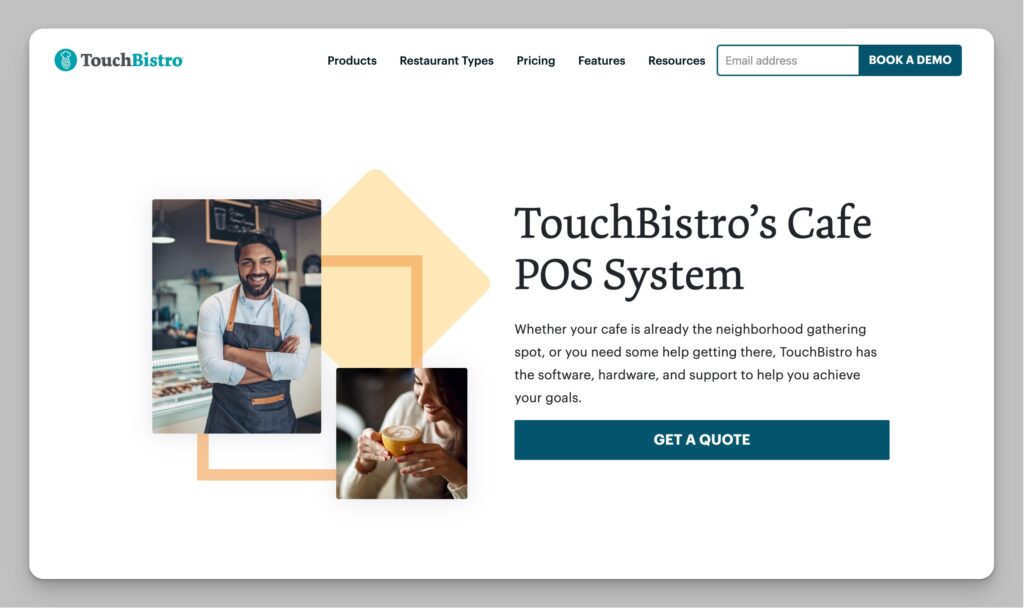
Founded in 2010 and headquartered in Toronto, Canada, TouchBistro is a leading provider of cloud-based Point of Sale (POS) systems specifically designed for the food service industry. With a focus on addressing the unique needs and challenges of modern-day restaurants and cafes, TouchBistro has become an essential tool for over 29,000 establishments worldwide.
As a fully integrated management system, TouchBistro streamlines operations and elevates the guest experience. The platform offers a comprehensive suite of standard POS features, including:
- Payment processing
- Inventory management
- Table management
- Menu and ingredient management
- Staff management
- Reporting and analytics
What sets TouchBistro apart from many other POS systems is the seamless integration of these features, creating a cohesive and efficient solution for business owners.
Beyond managing daily operations, TouchBistro is committed to enhancing the guest experience. By offering functionalities such as bill-splitting, tableside payment processing, online order management, and loyalty program handling, TouchBistro caters to the ever-evolving needs of today’s customers.
TouchBistro Pricing & Hardware
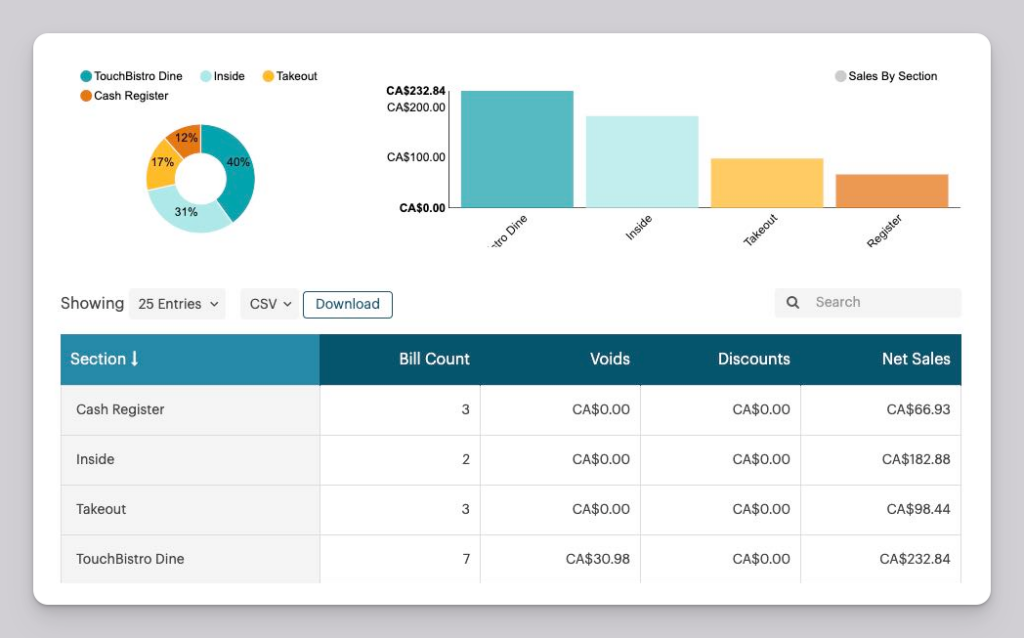
TouchBistro User Reviews
Here is a summary of my analysis of user reviews, testimonials, and complaints about TouchBistro as seen on major review sites like Capterra, G2, and others.
- Ease of Use: The user interface is generally praised as user-friendly and easily navigable, making it simple for staff to manage tasks and learn the system.
- Robust Features: TouchBistro offers comprehensive features for managing a wide range of restaurant operations, from room charges to extensive menus.
- Menu Management: Users enjoy the intuitive platform for updating pricing, adding and removing items, and overall menu customization.
- Self-Ordering Kiosk and Offline Functionality: The self-ordering kiosk feature for customer upgrades and the ability to operate without internet are well-received.
- Quick and Efficient Order Taking: Utilizing iPads, the TouchBistro POS allows for efficient order taking directly at the table, enhancing the guest experience.
- Inventory Tracking: Although it requires extensive setup, the inventory tracking capabilities are detailed and offer significant benefits once in place.
- Responsive Customer Service: Some reviewers cite the customer service team as being quick to respond and helpful, often implementing suggested features.
- Ongoing Software Improvements: The company is recognized for continuously rolling out new features and for being supportive during the challenges faced by the restaurant industry.
Technology Issues During Updates: Users experience significant technology issues when updates to TouchBistro are required, leading to potential downtime that businesses cannot afford.
Difficulties with Customer Support: Reaching customer support can be time-consuming, and some users face lengthy wait times and get passed from one representative to another.
Challenges with Reporting: Obtaining comprehensive reports is cumbersome, and the analytics provided are found to be lacking in depth by some users.
Onboarding and Training Challenges: Users noted the onboarding process could be difficult, and the lack of user-friendly support materials led to some businesses having to create their own training manuals.
Wi-Fi Connection Problems: Some users reported intermittent Wi-Fi connection issues, which occasionally require modem resets.
System Stability and Bugs: Instances of the system disconnecting daily, causing significant operational burdens and frustrations.
Limited Remote Management: Managing multiple restaurants or making substantial changes remotely is problematic due to limitations of the system’s infrastructure.
Where TouchBistro Stands Out For Cafes
Streamlined Operations: TouchBistro is designed to enhance the speed and efficiency of service. The system’s “Fast Bar” register mode and tableside ordering system significantly speed up the ordering process, allowing cafes to serve more customers in less time. The user-friendly interface makes it easy for staff to learn and use the system, reducing training time and improving service efficiency.
Payment Processing and Management: TouchBistro has quick payment processing and payments, enhancing service speed and customer convenience. The system allows for various payment options, including swipe, dip, tap, and mobile payments, catering to customers’ preferences. It also enables easy bill splitting and table transfers, further enhancing the customer experience.

Customer Engagement and Loyalty: TouchBistro POS encourages repeat business with enticing promotions and loyalty programs. The system also offers advanced online ordering that enables customers to schedule pickup and delivery orders hours or days in advance, expanding the cafe’s reach and convenience for customers.
Staff Management: TouchBistro provides valuable staff management tools, including staff permission management to minimize theft and an integration with 7Shifts for effective staff scheduling. These features help cafes manage their labor costs and ensure adequate staffing during busy times.
Business Insights and Reporting: TouchBistro has comprehensive reporting with over 50 detailed reports. These reports provide real-time data on daily and weekly revenue, tracking popular premium coffee blends, and identifying staff members who delete an unusually high number of items from tabs. These insights empower coffee shop owners to make informed decisions to boost business performance
Where TouchBistro Falls Short
- Limited integrations: While TouchBistro has a number integrations available, it may not have as many options as other POS systems. This could be a limiting factor for businesses that require more extensive integrations with other software and platforms.
- Online ordering: TouchBistro relies on integration with Deliverect to connect to other delivery services than DoorDash Drive.
- Limited reporting: There are certain areas where the reporting features need improvement to generate more useful sales, employee performance, and inventory reports.
Key Takeaways about TouchBistro for Cafes:
- Streamlined operations with fast bar register mode and tableside ordering.
- Payment processing and management, including bill splitting and table transfers.
- Customer engagement and loyalty features with advanced online ordering.
- Staff management tools, including permissions and scheduling integration.
- Business insights and reporting for data-driven decision-making.
Designed by restaurant industry veterans
Best for independent coffee shops looking for a well designed, feature-rich, fast and secure cloud/server-based POS system.
- Fast & easy-to-use
- Tab management, bill splitting & table transfers
- Excellent offline functionality
- Fewer integrations than competition
- Somewhat limited reporting features
Toast vs. Square vs. Lightspeed vs. SpotOn vs. TouchBistro
Toast: Designed for the restaurant industry, Toast’s POS system offers an intuitive, easy-to-use interface that minimizes staff training time, vital for a fast-paced coffee shop environment.
Toast has integrated tools for quick order entry and digital tickets, reducing potential human errors. Notably, it provides flexible payment options, including kiosk, online, and QR code ordering. Daily reporting features can help coffee shop owners optimize their menus, while the built-in loyalty program encourages repeat business.
Toast: With its comprehensive features and customizable options, Toast is well-suited for mid-sized to large coffee shops or chains that handle a high volume of transactions daily.
The ability to track daily sales and customize menus is especially beneficial for coffee shops that frequently rotate their offerings or have seasonal specials. Toast’s loyalty program feature would be particularly useful for businesses with a stable customer base.
The most innovative POS system on the market
Best for larger coffee shops that serve food and want takeout and online ordering features.
- Rapid development of new features
- Toast Takeout system
- Rugged mobile hardware devices
- Android only
- Locked into Toast payment processing
Square’s POS system offers ease of setup and is designed to speed up checkouts, vital in managing the morning and afternoon rushes common in coffee shops. It allows businesses to accept all types of payments, enhancing customer convenience. Square’s system also includes a customizable tipping feature and integrates online and in-person orders. Importantly, the software is free to use, with businesses only paying when they accept a payment.
Square: The ease of operation makes it an ideal choice for small coffee shops, pop-ups, or mobile cafes that need a simple, affordable solution. Its unified system for tracking online and in-person orders would be beneficial for coffee shops offering both sit-in and takeaway services. Plus, the lack of a monthly fee can be an advantage for startups or small businesses operating on a tight budget.
The fast and easy-to-use system
Best for new or smaller cafes that want to start on a free plan and want to sell products online.
- Subscription free plan
- No long term contracts
- Integrates with the Square ecosystem
- Lacks some advanced features
- No on-site support
Lightspeed’s POS system emphasizes a customer-centric approach and offers flexibility, such as ordering directly from an iPad POS. It has a range of contactless payment options and built-in loyalty programs. Additionally, it offers online ordering and integrates with major food delivery apps.
Lightspeed would be a great fit for coffee shops focused on enhancing their customer service and personalizing their offerings. The system’s flexibility, coupled with its online ordering and delivery integrations, would suit both sit-down cafes and coffee shops with a significant takeaway or delivery business. Larger coffee shops or chains would also benefit from Lightspeed’s multi-location management feature.
Cleverly crafted POS with exceptional design
Best for upscale coffee shops seeking powerful inventory, data insights, and retail features.
- Ease of use & interface design
- Reporting & analytics
- E-commerce capabilities
- Limited offline functionality
- Not the cheapest option
TouchBistro: Designed to increase sales, TouchBistro’s POS system offers a digital loyalty program, POS-integrated barcode scanner, and pop-up reminders for cross-selling and upselling. TouchBistro also provides features for saving time and money, such as predictive quick register buttons and integrated payment processing. Over 50 reports offer valuable insights into sales and operations.
Given its emphasis on increasing sales and its rich set of features, TouchBistro would be well-suited to busy, high-traffic coffee shops aiming to boost their profits and optimize operations. The predictive quick register buttons and integrated payment processing can expedite transactions during peak hours, making it ideal for coffee shops in busy areas like city centers or transport hubs.
Designed by restaurant industry veterans
Best for independent coffee shops looking for a well designed, feature-rich, fast and secure cloud/server-based POS system.
- Fast & easy-to-use
- Tab management, bill splitting & table transfers
- Excellent offline functionality
- Fewer integrations than competition
- Somewhat limited reporting features
SpotOn POS focuses on quick coffee orders and fast payments. It offers robust customer support, including 24/7/365 technical phone support. Its POS system integrates seamlessly with its other restaurant solutions, providing a comprehensive toolkit for coffee shop owners. Unique offerings include QR code ordering and a highly visual dashboard for data-driven decisions. Its online ordering platform allows coffee shop owners to retain control of the ordering process and marketing data.
SpotOn’s emphasis on swift transactions and intuitive order processing make it suitable for bustling coffee shops where speed and efficiency are paramount. Its QR code ordering can help manage long queues, making it beneficial for urban, high-traffic coffee shops. The comprehensive data visualization tools would also be useful for coffee shop owners who take a data-driven approach to manage their business.
Feature rich all-in-one POS solution with modern bar-specific features
Best option for bars with outdoor seating looking for great mobile hardware devices.
- Wide selection of hardware devices
- Low credit-card processing fees*
- No long term contracts
- Limited offline functionality
- Requires SpotOn devices
- *Requires SpotOn Payment for low fees
Summary and Conclusion
In conclusion, all five of these cloud-based POS systems are versatile and feature-rich, and they can be tailored to meet the needs of a wide variety of establishments.
Explore these systems further by visiting their websites and scheduling demos or free trials. Get hands-on experience with the platforms that catch your eye.
Remember that choosing the right POS system can make a significant impact on your business’s success. It can enhance efficiency, improve customer satisfaction, increase revenue opportunities, and provide valuable insights for smarter decision-making.
Start exploring TouchBistro’s streamlined operations or Toast’s exceptional guest experience. Dive into SpotOn’s optimization tools or Lightspeed’s customizable layouts and inventory management capabilities. Or consider Square’s efficiency-focused features.
It’s time to transform your coffee shop or cafe into an operation where customers are delighted at every interaction.
You might also like these POS comparisons:
- TouchBistro vs. Lightspeed Restaurant
- Square for Restaurants vs. Lightspeed Restaurant POS
- Toast vs. Lightspeed Restaurant: Choosing The Right POS
- Toast vs. TouchBistro: Choosing Your Perfect Restaurant POS
- TouchBistro vs. Square for Restaurants: Which POS is Better?
- Toast vs. Square: Which Restaurant POS is Right for You?


